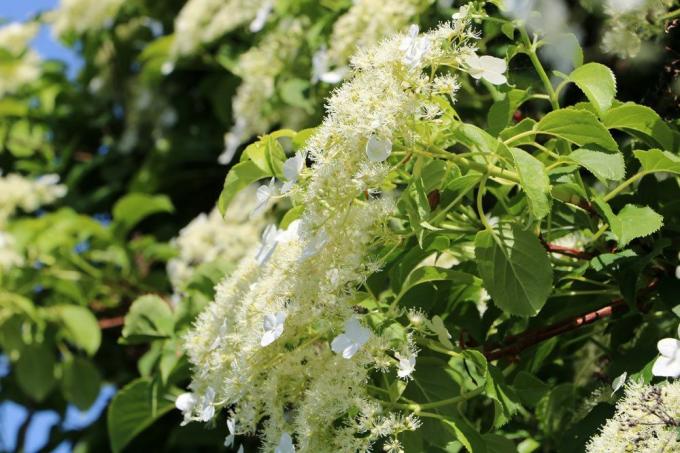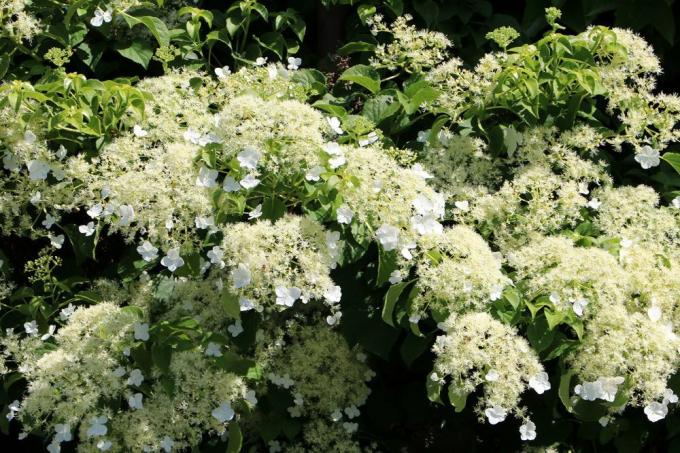
table of contents
- Cordifolia
- Miranda
- Semiola
- Silver lining
Climbing hydrangeas (Hydrangea petiolaris) originally come from Asian forests. However, they are hardy even with us and can reach heights of several meters. They mostly bloom white and climb with the help of adhesive roots.
Cordifolia
This cultivar does not grow as large as its relatives. Therefore, it is also suitable for small gardens or as a decoration for the terrace and balcony. If it is not led up on a trellis, it remains around 60 cm small and grows spherical. However, their roots also make house walls green. Unlike ivy, climbing hydrangeas do not tend to penetrate deep into the masonry. They are therefore better suited as permanent house greening.

- Location: shady or partially shaded, root area cool and moist
- Size: trailing up to 3 m, otherwise remains small
- Flowering period: June to July
- Flower color: cream-white
- Leaf decoration: only summer green, but attractive red-brown shoots in winter
Miranda
This type of climbing hydrangea also remains rather small. With a suitable climbing aid, however, it can grow several meters in height. The attractive foliage works well as a privacy screen in the garden. On the balcony or terrace, the plant is content with a larger container and then needs a protected location without blazing sun, otherwise the soil will dry out too quickly.

- Location: shady, cool, moist, no waterlogging, partial shade is tolerated
- Size: up to 3 m high, growth without climbing support remains smaller, then also covers the ground
- Flowering period: June to July, makes particularly large flowers
- Flower color: cream-white
- Leaf decoration: variegated yellow, summer green
Semiola
This variety is a new breed, which is characterized by its evergreen foliage and the ability to grow up to 250 cm high even without a climbing aid. It is important that this climbing hydrangea needs winter protection if very severe frost is to be expected. Otherwise, it will shed its leaves and may even freeze to death. The first flowers open after 2 to 3 years of standing. This climbing hydrangea then blooms regularly and profusely.

- Location: preferably grows in partial shade, but also sunny, soil as moist and shady as possible
- Size: up to 250 cm high and 150 cm wide, can be used as a ground cover
- Flowering period: May to June
- Flower color: white
- Leaf decoration: evergreen, shedding leaves in cold winters, copper-red shoots in spring
Note: If this variety is to grow in a certain shape, it needs a corresponding climbing aid to guide it and an annual shape-giving pruning.
Silver lining
This cultivated form of the climbing hydrangea is not only very long-lived, it also climbs the highest. To do this, it must be planted freely in the garden. It is suitable as a Container plant, but then remains much smaller due to the narrow root space. This variety does not need any climbing aid, its adhesive roots are strong enough to climb up suitable walls or fences on their own without causing damage. This variety is characterized by its insect friendliness.

- Location: prefers partial shade, but also tolerates sun or full shade, moist soil, avoid waterlogging
- Size: growing freely up to 15 m high and 2 m wide, otherwise remains smaller, upright growth up to about 2 m
- Flowering period: May to June
- Flower color: white
- Leaf decoration: bright green, white edge, shedding leaves
Note: All climbing hydrangeas like little lime and a shady soil area because they are shallow roots and have a high water requirement.



